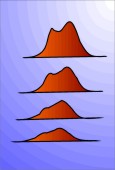
Fluorescence represents emission of light after absorption of light.
In plants the far-red chlorophyll fluorescence has been studied best. Apart from this, there is the blue-green fluorescence which has been examined recently in more detail and which is detected from phenolic compounds (e.g. ferulic acid) of the epidermis.
Since intact plants convert the energy absorbed by the light absorption of chlorophylls also into photosynthesis, one can conclude from the height of the fluorescence on the intensity of photosynthesis. The connection between chlorophyll fluorescence and photosynthesis which is as a first approach reciprocal has been studied already nearly 70 years ago by H. Kautsky (Kautsky H, Hirsch A (1931) Neue Versuche zur Kohlenstoffassimilation. Naturwissenschaften 19: 964). The change of the chlorophyll fluorescence of a leaf during the conversion from the dark into the light (induction kinetic or "Kautsky-effect") gives information on the photosynthetic activity which are achieved much more easily than with the conventional methods of measuring photosynthesis (CO2-fixation or O2-evolution).
If the fluorescence is spectrally resolved, one can conclude from the measured fluorescence-emission spectrum on the pigment composition of a sample. The fluorescence of chlorophyll is situated between 650 and 800 nm with maxima at 690 nm (far-red) and 740 nm (near infrared). The fluorescence of phenolic substances is situated between 350 and 600 nm with maxima at 440 nm (blue) and 540 nm (green). The measurable fluorescence emission spectrum of a leaf is essentially influenced by the absorption of pigments, which re-absorb part of the fluorescence light emitted inside of the leaf. From the re-absorption one can conclude on the concentration of pigments. The emission spectrum of the chlorophyll fluorescence of an intact leaf changes during the conversion from the dark into the light ("Kautsky-effect", see above). By means of a spectrometer recording spectra within few milliseconds, one could show in 1981 for the first time that the position of the fluorescence maxima remains but the ratio of the maximum at 690 nm to that at 740 nm is decreasing (Buschmann C., Schrey H. (1981) Fluorescence induction kinetics of green and etiolated leaves by recording the complete in vivo emission spectra. Photosynthesis Research 1: 233-241).
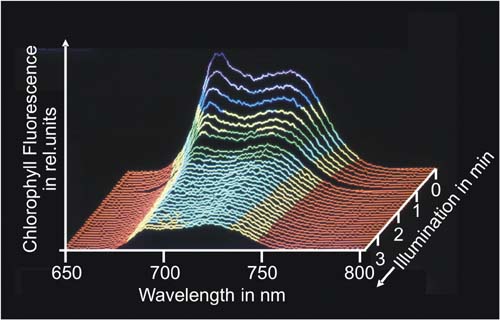
Spectra of the chlorophyll fluorescence of an intact green leaf during illumination subsequent to a pre-darkening (Kautsky-Induction kinetic): The time axis runs form the back (0 min) to the front.
Recently fluorescence image analysis of plants has been carried out. This is done by recording with a highly sensitive video-camera. From the distribution of the fluorescence intensity one can conclude on the pigment composition and eventually on the photosynthetic activity. Fluorescence images with several thousands of picture elements more reliable than the otherwise used fluorescence measurements only at one point of the sample. Furthermore one can draw further conclusions (e.g. on different stress types) from the distribution pattern of the fluorescence signals.
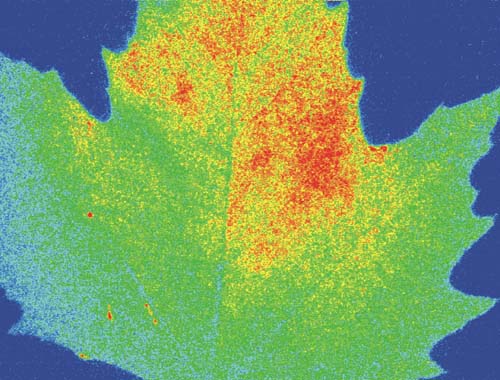
Fluorescence image of a Platanus leaf: Intensity of chlorophyll fluorescence at 740 nm is shown in false colour
(increase of intensity: blue - green - yellow - red)
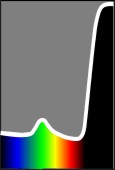
When measuring #reflectance one determines the radiation remitted by a sample.
The incident radiation is changed by absorption and stray effects which are characteristic for the sample. Thus one can conclude from the reflectance on the properties of the sample. With plants one measures, in most cases, the reflectance of the leaves which make up the largest area of a plant. With leaves it are especially the pigments and the cover of the epidermis which determine the reflectance and which can be deduced from reflectance spectra. In particular for improving the interpretation of remote sensing data a laboratory spectrometer was developed which can measure spectra of reflectance, absorption and fluorescence in the visible and in the infrared (VIRAF: Visible Infrared Reflectance Absorption Fluorescence). The advantage of the instrument is that all spectra can be measured without changing the position of the sample (better comparison of the spectra than with repeated fixing of the sample in different instruments). Furthermore the leaves can be measured without cutting them from the plants, in order that the leaf samples do not dry out.

Photoacoustics is the measurement of heat production after light absorption.
The photoacoustic effect was found in 1881 by Alexander Graham Bell: If a sample absorbs light the absorbing molecule takes up the light energy and is transferred from its ground state to its excited state. Afterwards, the molecule goes back again from the excited state to its ground state. In doing so, energy is transformed into heat (eventually also into fluorescence and/or photochemistry) which is then released. This heat produced by the "non-radiative transition" of the excited molecule is measured by photoacoustics.
During a photoacoustic measurement the sample is enclosed in a small, tightly closed sample compartment, the photoacoustic cell. The sample is illuminated by pulsed light shining through a glass covering the cell. If the light is absorbed the sample transmits heat to the surrounding air. The warmed air is expanding. Since the irradiating light is pulsed, heat is produced also in pulses. The heat pulses created by the light (photo-) can be measured as rhythmic pressure changes by means of a microphone (-acoustic).
Photoacoustic measurements can be carried out with intact leaves. The advantage of photoacoustic measurements with intact leaves consists in the fact that:
(a) absorption properties can be measured, without the typical problems of absorption measurements of strongly light scattering samples like leaves,
(b) the measurement of absorption properties is possible for different sample depths without prior preparation ("depth profiling") by simply changing the frequency of the light pulses,
(c) the measurement of non-radiative transitions completes the understanding of the energy balance of photosynthetically active samples (absorbed light energy is transferred into photosynthesis, chlorophyll fluorescence and heat).
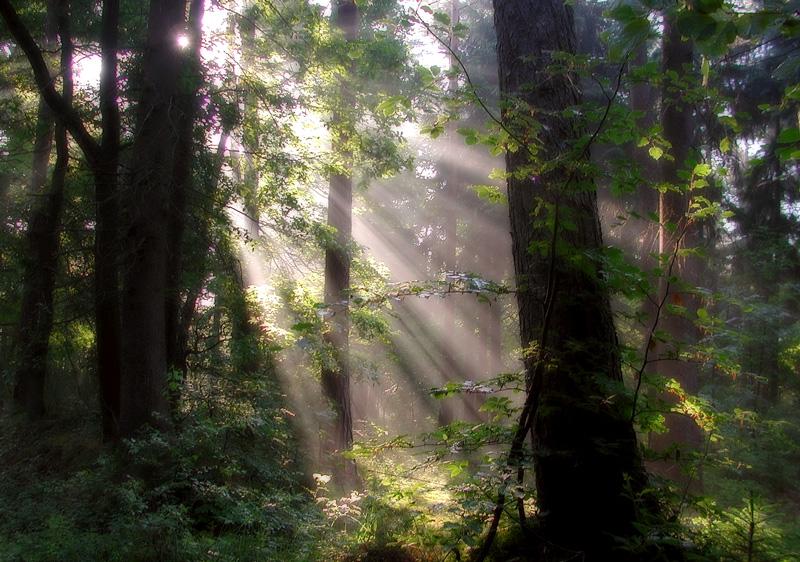
The Ecophysiology is suitable as field of application in the environmental research especially for photosynthesis research.
In particular the in vivo measurement of fluorescence, reflectance and photoacoustic can be applied to detect natural and anthropogenic stress effects. These non-destructive evaluation methods can be carried out with leaves in the laboratory or out-door and allow the characterization of plants and of a plant canopy, respectively, which can be connected to other measurements (e.g. also remote sensing of vegetation).

